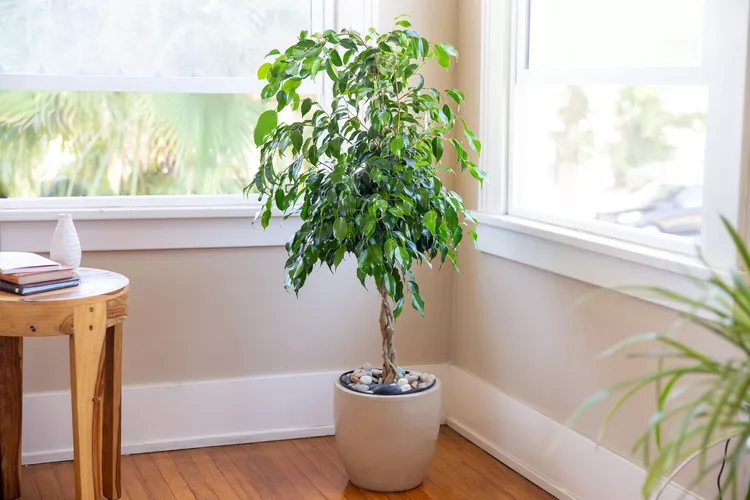
Ficus benjamina is a species of flowering plant in the family Moraceae that is native to Asia and Australia. It is also known as the weeping fig, benjamin fig, or ficus tree and is frequently sold in stores as plain ficus. It serves as Bangkok’s official city tree.
Monoecious F. benjamina is. The inflorescences are 1.5 cm (12 inch) in diameter, spherical to egg-shaped, and bright green. There are three different kinds of flowers in the inflorescences: male, fertile, and sterile female flowers. The male, stalked, dispersed flowers feature free sepals and a stamen. Sessile female flowers with three or four sepals and an ovary in the shape of an egg are common. An enlarged scar results from the more or less lateral style.
Care
Weeping figs, which can grow up to 60 feet tall as specimen trees in tropical regions, are also occasionally cultivated and trimmed as hedges. In containers filled with soil-based potting mix that are placed in bright indirect light or in sunny locations that receive some afternoon shadow, weeping figs thrive readily inside. During the growing season, the plant needs to be constantly watered; however, from fall to late winter, it can become drier.

Light
The weeping fig requires a bright space with lots of indirect light and sometimes even some morning direct sunshine. Although it is frequently cultivated in semi-shaded areas in its natural habitat, adequate light is necessary for it to flourish indoors. It needs to be kept in a pleasing, well-lit area. It should be noted that this plant has a great tolerance for movement, even if it is to find better lighting conditions, so it is preferable not to try to locate the ideal position by experimenting.
Soil
Any decent, quickly draining potting soil should work. Weeping figs don’t require particularly nutrient- or organic-rich soil. Use a soil-based potting soil when repotting that includes perlite, sand, and vermiculite for better drainage.
Water
Keep the plant consistently moist, but don’t let it sit in water—that will cause it to lose leaves and possibly even develop root rot. Plants in their natural habitat generally lose their leaves at the start of the dry season, making them extremely sensitive to fluctuations in moisture. Ensure that your watering schedule is reliable.
Temperature and Humidity
Temperatures between 65 and 70 degrees Fahrenheit at night and 75 to 85 degrees Fahrenheit during the day are ideal for ficus trees. To control temperature changes in your home, think about adjusting your thermostat. Avoid using excessive air conditioning throughout the summer because weeping figs will suffer if the temperature inside falls below 70 degrees Fahrenheit.
Weeping figs are native to tropical regions and favour heavy humidity. Leaves that are dry and shriveled up can be the result of low relative humidity. 3 If you want to control the humidity in your house, think about utilizing a humidifier. To keep your tree’s leaves from drying out, keep the soil surrounding its base moist and spray them occasionally.
Fertilizer
Because they consume a lot of food, these plants require a lot of fertilizer during the growing season. Slow-release pellets should be fed to your ficus at the start of the growing season. They will benefit from fertilizing every month in the spring and summer and every two months in the fall and winter because they grow quickly.
Try adding a little magnesium and manganese as a supplement if your plant is losing leaves despite having appropriate sunlight, temperature, humidity, and fertilizer levels.
Table





